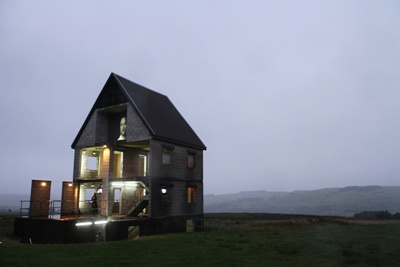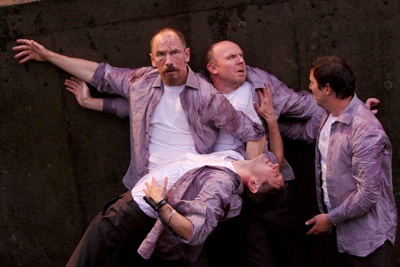A Janus-Faced Tragedy
01.10.10
Mike Pearson and Mike Brookes return to the Welsh heartlands with their brilliantly conceived, multi-media performance of The Persians, which was staged at the SENTA military training village at Mynydd Epynt in the Brecon Beacons in August 2010. The production, the flagship show in National Theatre Wales’ (NTW) inaugural season of new work, was inspired in part by Pearson’s involvement in an AHRC Landscape and Environment network grant in 2006-8 that used the site at Epynt for one of its case studies. Like other sites that have been forcibly requisitioned in Wales such as the Tryweryn Valley in the late 1950s, Epynt is a contested place, a blatant reminder, if one were needed, of the colonial violence inflicted on the Welsh landscape.
In Pearson’s and Brookes’ theatrical response to the site two years on, Aeschlyus’ The Persians, the oldest recorded script in Western drama, is used to create a complex weave of meanings and reverberations that collapse simple distinctions between past and present and here and there. Unlike Sophocles’ Oedipus trilogy or Euripides’ The Bacchae, The Persians, written in 472 BC, is a play that documents, mostly in reported speech, an event from contemporary Greek history: the rout of the Persian King Xerxes’ fleet at Salamis in 480 BC. Structurally, the lack of dramatic tension serves to further heighten the tragedy in this most melancholy and despairing of tragedies. In the roll-call of defeat and slaughter, nothing is allowed to distract from the characters’ reaction to the horror of the carnage relayed on a video screen first by the Messenger (brilliantly played by Richard Harrington), and then by Xerxes’ himself (Rhys Rusbatch) on his exhausted and abject return to native soil.

The training house at SENTA transformed into the set of The Persians. (Photo © Toby Farrow)
The intensity of Aeschylus’ language, well served by Kate O’Reilly’s new version, and movingly performed for the most part by a stellar cast (Rosa Casado, Richard Lynch, Richard Huw Morgan, John Rowley, Paul Rhys, Sian Thomas and Gerald Tyler) is reinforced in the production by John Hardy’s musical score, Mike Brookes’ acoustic design and staging and Simon Banham’s costumes and set elements. In the shell of one of the houses of the now deserted Cilieni village, redesigned by the Ministry of Defence in the 1980s to replicate an East German village in preparation for World World War III, Brookes, the co-director of the piece, has placed a series of monitors and LED screens. Through a dizzying montage of close-ups and live-feeds, these screens capture the anguish of the chorus, and the shared grief of Xerxes’ mother and Darius, his father, who has been raised from the dead to comment on the tragedy that has befallen his son and the empire of Persia. Brookes’ staging helps to establish the site-specific aesthetic of the piece. The materials and building belong to the site itself and are used by the military at SENTA for training. As such, they resonate with contemporary meaning and allow the audience to reflect on the clash of different cultures of “performance”. Yet at the same time, the purposefully designed ‘combat house’ is ghosted by an imaginary site from a period of ancient history: the Royal Palace at Susa. In this mix of bodies, times and landscapes, both real and imagined, it is easy to feel disorientated. Yet, such disorientation does not weaken the play or deaden our experience of it; rather, it encourages the spectators to think, to imagine, to create connections between different continents, histories and events.
The landscape is a vital ingredient in the play’s success. The audience walks through the empty streets of Cilieni village; watches vintage cars and protagonists arrive with the sun and mountains - extinguished volcanoes - at their back; and perceives the tragedy unfold in tandem with dramatic shifts in light. The effect is tremendous; it reminds us of how for the Greeks, tragedy was elemental - theatre in the sky.

The Chorus - Gerald Tyler, John Rowley, Richard Huw Morgan and Richard Lynch. (Photo © Toby Farrow)
It is a testament to Pearson’s and Brookes’ skills as makers of site-based performance that the play, despite its military setting, is not simply used to comment allegorically on relations between the West and the Islamic world, as it often has been since the start of the first Gulf War in 1991. Rather, the site grounds the work, necessarily, in local as much as international concerns. Indeed, it is tempting to see this version of The Persians as a continuation of Pearson’s project with the influential Welsh-language company Brith Gof in the 1980s and 1990s, and in the past decade or so with his series of city-based performances in collaboration with Brookes (Carrying Lyn, Polis and Rain Dogs. In that work, characterised by what might be best defined as ‘an archaeology of destruction’, Pearson has been concerned to take the temper of the times in Wales, to excavate repressed histories and to allow unspoken anxieties and tensions to appear. As the communities of Wales confront, yet again, the brutal realities of funding cuts, job losses and the decimation of the welfare state, Pearson’s and Brookes’ take on The Persians, like Brith Gof’s legendary production of Gododdin at the abandoned Rover car plant in Cardiff during the Thatcher years, asks what nationhood might mean in an age of economic barbarism and social destitution.
Performed in Wales in the late summer of 2010, Pearson’s and Brookes’ production of The Persians is Janus-faced, a play that looks back to national disasters past and forwards to the catastrophes that will surely come. However, it is precisely the bleakness of this vision that permits The Persians to become, by some distance, the most important and pertinent play in NTW’s season to date. The production’s pessimism and seriousness are exactly what NTW, who pride themselves on producing world-class work for national and international audiences, ought to be exploring. It is challenging work like this that will allow the company to create the ‘theatrical mapping’ of Wales to which they are so committed. And, in this context, it is surely worth reflecting that the final word of the play, repeated in a whispering lament, is ‘tears’.
Carl Lavery